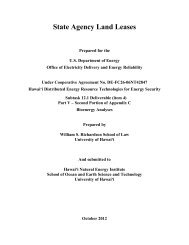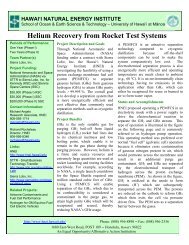- Page 1 and 2: Oahu Wind Integration Study Final R
- Page 3 and 4: 1.0 Executive Summary Hawaii is an
- Page 5 and 6: Oahu 100MW Wind 100MW PV Lanai 200M
- Page 7 and 8: Figure 1-2. Renewable Integration S
- Page 9 and 10: educe its output, while remaining i
- Page 11 and 12: Figure 1-6. Share of annual energy
- Page 13 and 14: Figure 1-8. Total annual variable c
- Page 15 and 16: extreme downward variability over t
- Page 17 and 18: 1.6. Short-timescale wind variabili
- Page 19 and 20: Figure 1-11. Frequency performance
- Page 21 and 22: down-reserve requirement. Alternati
- Page 23: capability, the remaining 163 MW of
- Page 27 and 28: 1.8.2. Thermal Unit Modifications
- Page 29 and 30: 6.3.1. Overview of the GE MAPS TM B
- Page 31 and 32: 10.5.3. Down-reserve...............
- Page 33 and 34: Figure 6-13. Baseline 2014 scenario
- Page 35 and 36: tripped off-island wind plant carry
- Page 37 and 38: Table 8-10. Summary of short-term a
- Page 39 and 40: 2.0 Acknowledgements Our team would
- Page 41 and 42: are presented in this section for S
- Page 43 and 44: 4.1. Study objectives The General E
- Page 45 and 46: human decision-making play a substa
- Page 47 and 48: Voltage Governor Support Response P
- Page 49 and 50: maneuvering that may be a result of
- Page 51 and 52: hours of operation that warrant fur
- Page 53 and 54: and maintenance costs) based on ass
- Page 55 and 56: Another factor for consideration is
- Page 57 and 58: Figure 5-3 GE MAPS TM model results
- Page 59 and 60: models of all of HECO-owned and IPP
- Page 61 and 62: Table 5-4 Proposed thermal unit gov
- Page 63 and 64: Table 5-6 Summary of various dynami
- Page 65 and 66: Table 5-8. Dynamic Database - Excit
- Page 67 and 68: o 50 MW Oahu2: Modeled as a 50 MW g
- Page 69 and 70: 400 MW Off-island Oahu Wind Plant M
- Page 71 and 72: turbine/governor systems in the dyn
- Page 73 and 74: Pulsating logic: o All units under
- Page 75 and 76:
Hz 60.8 60.6 60.4 60.2 60 Frequency
- Page 77 and 78:
modeled as a single CT/ST and is ba
- Page 79 and 80:
6.2.1. Development of Wind and Sola
- Page 81 and 82:
Estimated power curve P farm = 30MW
- Page 83 and 84:
Figure 6-3 The largest 1 minute win
- Page 85 and 86:
Figure 6-5. Histogram of wind power
- Page 87 and 88:
At the request of the evaluation te
- Page 89 and 90:
6.2.5. Reserve requirements The Oah
- Page 91 and 92:
Figure 6-10. Thermal unit heat rate
- Page 93 and 94:
6.3.1.5.2. AES coal-fired steam pla
- Page 95 and 96:
Figure 6-12. Baseline 2014 scenario
- Page 97 and 98:
Methods to forecast solar power wer
- Page 99 and 100:
1. No forecast of wind and solar (S
- Page 101 and 102:
Table 6-3. Scenario 5: Wind and sol
- Page 103 and 104:
Figure 6-18. Scenario 5. Fuel energ
- Page 105 and 106:
Table 6-4. Scenario 3: Wind and sol
- Page 107 and 108:
6.7. Conclusions As the wind energy
- Page 109 and 110:
Figure 6-21. Scenario 3. Fuel energ
- Page 111 and 112:
The results of the scenario analysi
- Page 113 and 114:
Reduce On-line Regulating Reserves
- Page 115 and 116:
energy is accepted, these units are
- Page 117 and 118:
Figure 7-3. Scenario 5C: Fuel energ
- Page 119 and 120:
Sce nario 5C Scenario 5F1 40MW down
- Page 121 and 122:
Scenario 5F1 Scenario 5F2 Seasonal
- Page 123 and 124:
7.4.1. Sensitivity to Solar Forecas
- Page 125 and 126:
on the time of day and the load lev
- Page 127 and 128:
Figure 7-15. Scenario 5F3. Number o
- Page 129 and 130:
Figure 7-18. Renewable energy deliv
- Page 131 and 132:
more expensive cycling energy displ
- Page 133 and 134:
Figure 7-23. Delivered wind energy
- Page 135 and 136:
18-weeks during the year was includ
- Page 137 and 138:
should be noted that the effective
- Page 139 and 140:
Note that the average heat rate for
- Page 141 and 142:
The heat rate by unit type is shown
- Page 143 and 144:
The capacity factors of the renewab
- Page 145 and 146:
On the other hand, short-term analy
- Page 147 and 148:
Table 8-2. Long term screening resu
- Page 149 and 150:
Figure 8-4. Drop in wind and solar
- Page 151 and 152:
emain flat in their generation for
- Page 153 and 154:
Hz Hz 60.2 60 Frequency AGC Mode 59
- Page 155 and 156:
Figure 8-9. Long-term analysis for
- Page 157 and 158:
The up-range adequacy of the system
- Page 159 and 160:
The short-term screening results fo
- Page 161 and 162:
MW 120 100 80 60 40 20 0 0 600 200M
- Page 163 and 164:
Hz Hz 60.2 60 59.8 59.6 59.4 0 600
- Page 165 and 166:
events., which will be described la
- Page 167 and 168:
Figure 8-18. Down-range10 at the be
- Page 169 and 170:
o Frequency performance (Section 8.
- Page 171 and 172:
MW 450 400 350 300 250 200 Scenario
- Page 173 and 174:
8.5.3. Results Using the volatile w
- Page 175 and 176:
MW 80 60 40 K2 K3 K4 K5 K6 MW 100 2
- Page 177 and 178:
Figure 8-30 shows that the maneuver
- Page 179 and 180:
• The load flow model in GE PSLF
- Page 181 and 182:
Frequency RMS (Hz) 0.035 0.03 0.025
- Page 183 and 184:
Intermediate Farm power 1 1+ sT + _
- Page 185 and 186:
In step 2 above, the 0.1% percentil
- Page 187 and 188:
1 / 120 per unit Ramp Rate Power (M
- Page 189 and 190:
MW 8.0 7.0 6.0 5.0 4.0 3.0 2.0 1.0
- Page 191 and 192:
MW MW 1.800 1.600 1.400 1.200 1.000
- Page 193 and 194:
Under the scenarios considered in t
- Page 195 and 196:
- No response (base case) - Moderat
- Page 197 and 198:
Hz MW 62 61.5 61 60.5 System freque
- Page 199 and 200:
esulted in noticeable improvements
- Page 201 and 202:
In both scenarios none of the 200 M
- Page 203 and 204:
Figure 8-49: Transient simulation r
- Page 205 and 206:
Figure 8-52: Transient simulation r
- Page 207 and 208:
o Wind turbine inertial response tr
- Page 209 and 210:
o Reducing the on-line regulating r
- Page 211 and 212:
9.2.5.3. Wind Plant Ramp Rate Limit
- Page 213 and 214:
o Given the high power rating of th
- Page 215 and 216:
power, thereby contributing to the
- Page 217 and 218:
10.1.5. Recommend that HECO evaluat
- Page 219 and 220:
10.2.2. Recommend solar plants to p
- Page 221 and 222:
o This recommendation assumes that
- Page 223 and 224:
acking down thermal units. In Scena
- Page 225 and 226:
o In Scenario 5F3 and 5F2 the regul
- Page 227 and 228:
10.5.5. Additional Operator Informa
- Page 229:
simultaneous occurrence of the larg




